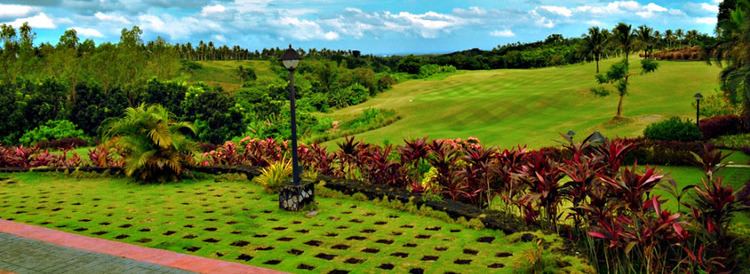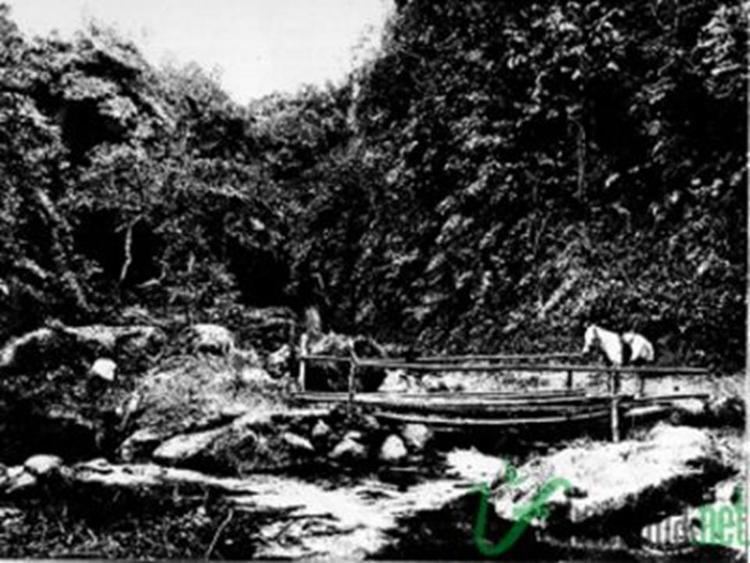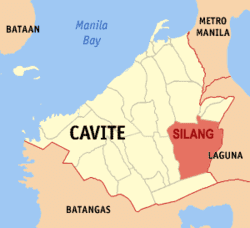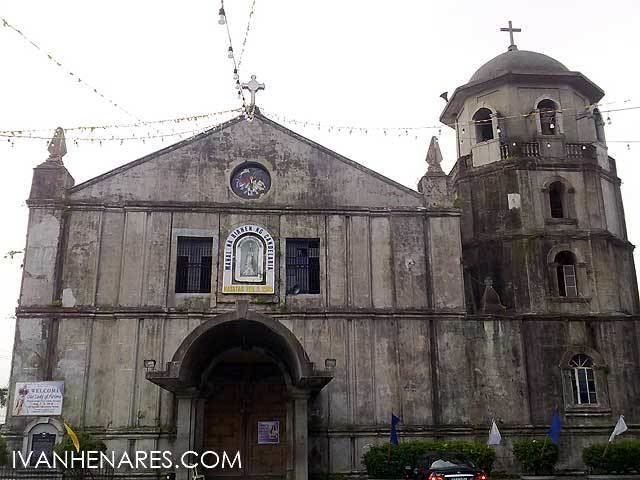Country Region CALABARZON | Area 209.43 km2 | |
 | ||
Colleges and Universities Adventist University of the Philippines, Adventist International Institute of Advanced Studies, Rogationist College | ||
Mayor Emilia Lourdes Poblete (Lakas-CMD) | ||
Map of Silang, Cavite
The Municipality of Silang (Filipino: Bayan ng Silang) is a first class landlocked municipality in the province of Cavite, Philippines. According to the 2015 census, it has a population of 248,085 people.
Contents
- Map of Silang Cavite
- Flying in the robinson r44 raven ii over silang cavite
- Geography
- Barangays
- Etymology
- Pre Hispanic period
- Spanish colonial era
- Demographics
- Religion
- Economy
- Transportation
- Places of interest
- Local government
- List of former executives
- Education
- References

Silang is located in the eastern section of Cavite. It is home to the Philippine National Police Academy, PDEA Academy, and International Institute of Rural Reconstruction head office.

With the continuous expansion of Metro Manila, the municipality is now part of the Manila's conurbation which spans southward toward Lipa City.

Flying in the robinson r44 raven ii over silang cavite
Geography
The municipality of Silang is 43 kilometres (27 mi) south of Manila. General Trias, Dasmariñas and General Mariano Alvarez (GMA) bound it on the north and on the west by Amadeo, Tagaytay on the south. Silang is noted for its relatively cool and invigorating climate.
Barangays
Silang is politically subdivided into 64 barangays.
Etymology
The name Silang was derived from the Tagalog word silanganan meaning "eastern", because the town is seated at the eastern portion of Cavite. A legend claims that it was coined from the Tagalog word isinilang or "given birth to", referring to the sudden and unusual emergence of the parish church. It may also refer to the new emergence of the land from the eruption of Taal Volcano on May 15, 1754. Whereas, three barangays of Silang are called Tubuan I, II & III.
Pre-Hispanic period
The traditional origins of the town are attributed to ten Bornean datus who sailed northward on board balangays and ended in Silang through Taal Lake. Its first settlers were Gat Hingiw, his wife Gat Kaliwanag, and their seven children, who later moved to different parts of the town and established their respective barangays. Gat Pandan stayed in the original community and developed the area.
Spanish colonial era
During the start of the Spanish colonization of the Philippines, tracts of land were given by the King of Spain to the conquistadores and their descendants, who collected tributes from the people residing in their acquired lands. Silang originally belonged to the encomienda (land grant) of Diego Jorge de Villalobos; his claim extended to what is today the towns of Carmona, Amadeo, Indang, Alfonso, General Trias, and Tanza.
The Silang encomienda was later purchased from King Ferdinand VI of Spain for 2,000 pesetas on March 9, 1746 to prevent it from becoming a "friar land" like the other towns of Cavite, executed through the representation of Bernabe Javier Manahan and Gervacio dela Cruz.
Demographics
In the 2015 census, the population of Silang, Cavite, was 248,085 people, with a density of 1,200 inhabitants per square kilometre or 3,100 inhabitants per square mile.
Religion
The majority of the people in Silang are adherents of the Christian Faith, composed of Roman Catholics, Protestants, and members of independent Christian groups. Majority of the Christian population is composed of Roman Catholics.
Other Christian groups in the town include mainstream Protestants, Baptists, Adventists, and non-denominational groups (Jesus Is Lord, Victory, Word for the World, Community Harvest, Community of Praise, Jesus Christ Spreading the Good News, Lord's Vineyard Covenant Community, Conquerors For Christ Intl. etc.),
Congregations of Mormons, Iglesia ni Cristo, Jehovah's Witnesses, and Members Church of God International (Ang Dating Daan) are also present in the town.
With the influx of migrants from other provinces, other non-Christian faiths, particularly Islam, is practiced in the town.
Economy
Silang, like most of the towns in the province of Cavite, depends on a mainly agricultural economy. The primary crops grown in the area are coconut, coffee, corn, banana, pineapple, and tree crops like mango, lansones, caimito, santol, jackfruit, guava, and avocado. Fertile soils and abundant water sources make Silang suitable not only for common commercial crops but also for high value and exotic crops production. Most of the local farmers practice intercropping to increase land productivity and lessen soil erosion. Fruit production exceeds the demand of the municipality's population, thus, supply excesses are marketed to Metro Manila and neighboring urban centers. A number of poultry and swine farms are also located in some rural barangays.
Manufacturing and trade are Silang’s other major sources of income. Trade and investments grew tremendously with the influx of both Manila-based and foreign investors. Total investments were estimated at P2.5 billion between 1996 and 2004, which helped bring about the employment of 3,000 people. Despite the slow down of progress in 2004, Land Value still soared, allowing investors to infiltrate and start business. The investment trend resulted in the increase in the price of prime realty from P3,000 to P15,000 per square meter and from P150 to P500 per square meter for raw lots in interior barangays. Trade establishments in Silang include gasoline stations, convenience stores, lumber/hardware traders, groceries, resorts, and hotels.
The dry goods section of the Silang Public Market can now accommodate 228 stalls.
Silang houses the Maguyam Industrial Complex and the Daichi Industrial Complex in addition to a total of ten factories operating outside the export processing zone.
Transportation
Silang can be reached by bus, or by jeepney. Coming from Manila, it will take 2 hours to reach the town proper. Silang is accessible by land transportation. Major road networks to and from Laguna and Batangas traverse it making the town a potential trading center for agricultural products while enjoying an environment that is free of traffic and pollution problems. Commuters are assured of smooth travel within the borders of the municipality with of its good road networks of approximately 187.83 km. Six major road projects were completed in 1996. These are the Bulihan Resettlement Area Road, the 8-km Kaong-Maguyam Road, the Caramanzana Drive connecting the Silang Public Market with Aguinaldo Highway, the 2-km Sabutan-Iba Road, the DPWH funded Sta. Rosa-Silang-Tagaytay Road, and the Malabag Road
Places of interest
Local government
Elected officials:
List of former executives
Gobernadorcillo (Leader of 'pueblo' or bayan during Spanish Era):
As the effect of the Maura Law in 1893, the tribunal del pueblo was changed to tribunal municipal and leaders of municipalities were called Capitan Municipal:
- Victor Belardo 1893-1894
- Nicolas Montoya 1895-1896
- Martin Medina 1896
- Isidoro Montoya 1896-1897
- Marcelo Madlansacay (former gobernadorcillo) 1897
- Vicente Poblete 1897-1898
- Jose Kiamzon 1898-1901
During the American Period, the 2nd commission passed the Municipal Code (Act No. 82) that created Municipalities. The leaders were called Presidente Municipal: First Elections were held 1903. (Silang Historical Society)
Municipal Mayor(s):
Education
Public elementary schools:
Government high schools:
Private schools:
Catholic schools:
Colleges, state colleges and universities:
